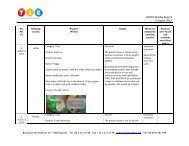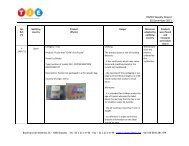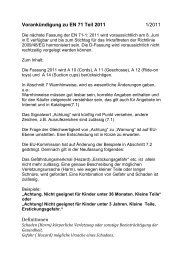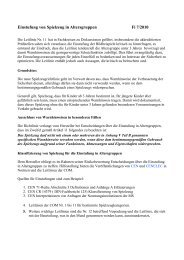You also want an ePaper? Increase the reach of your titles
YUMPU automatically turns print PDFs into web optimized ePapers that Google loves.
<strong>EN</strong> <strong>71</strong>-1:<strong>2005+</strong><strong>A8</strong>:2009 (E)<br />
If more than one type of projectile is supplied with the toy, the kinetic energy of each type of projectile shall be<br />
measured.<br />
8.24.2 Kinetic energy of bows and arrows (see 4.17.4)<br />
For bows, use an arrow intended for the bow and stretch the bow string, using a force of 30 N or less, as far<br />
as the arrow allows but to no more than 70 cm.<br />
Measure the kinetic energy as specified in 8.24.1.<br />
8.25 Plastic sheeting<br />
8.25.1 Thickness (see 4.3, 5.3 and 6)<br />
8.25.1.1 Apparatus<br />
Measuring device, capable of measuring thickness to an accuracy of 1 µm according to ISO 4593.<br />
8.25.1.2 Procedure<br />
Without stretching the plastic bags, cut along the seams so that two single sheets are produced.<br />
Measure the thickness of any sheet at 10 equidistant points across the diagonal of any area having<br />
dimensions of at least (100 x 100) mm, and average the readings.<br />
8.25.2 Adhesion (see 5.3)<br />
8.25.2.1 Apparatus<br />
Feeler gauge, with a thickness of (0,4 ± 0,02) mm and an insertion edge radius of approximately 3 mm<br />
-(see Figure 16)..<br />
8.25.2.2 Procedure<br />
Using a force of (25 ± 2) N, insert the feeler gauge between the component and the underlying layer or body<br />
of the toy at any angle between 0° and 10° from the toy surface. The feeler gauge shall be inserted at any<br />
place around the component but shall not be inserted at the same place more than 5 times.<br />
Perform the test 30 times.<br />
Determine whether the gauge is inserted more than 2 mm.<br />
8.26 Brake performance<br />
8.26.1 Brake performance for toys other than toy bicycles (see 4.15.1.5)<br />
Load the toy as in 8.21 (static strength) and place it on a plane inclined at (10 ± 1)° covered with a surface of<br />
abrasive paper (aluminium oxide P60) with its longitudinal axis parallel to the incline. Apply a force of<br />
(50 ± 2) N in the direction in which the brake handle is normally operated. Apply the force to the brake handle<br />
at the point where it is normally applied in use.<br />
If the brake is operated by a pedal, apply the force to the pedal in the operating direction to produce the effect<br />
of the brake.<br />
If the toy has several brakes, test each brake separately.<br />
Determine whether the toy moves more than 5 cm.<br />
62








